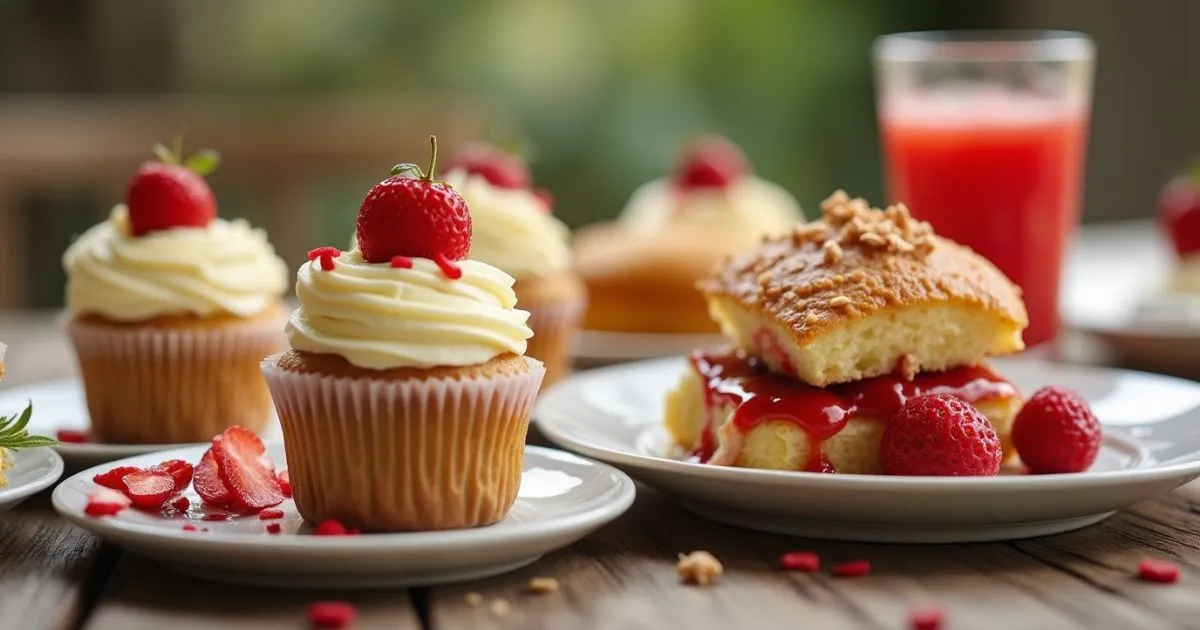Last updated on November 16, 2024
Few desserts are as universally loved as cupcakes. They’re festive, satisfying, and perfect for nearly any occasion, from casual afternoons to birthday celebrations. But if you’ve ever tried baking gluten free cupcakes, you know they can be tricky. Maybe you’ve dealt with cupcakes that were too dry, too dense, or fell apart after one bite. I’ve been there too, and after many attempts, I discovered a few secrets that completely transformed my gluten-free cupcakes. With these tips, you can create cupcakes that are moist, fluffy, and so delicious, you’d never guess they’re gluten-free. Let’s dive into these tried-and-true secrets to make the best gluten-free cupcakes ever!
Table of Contents
Why Baking Gluten Free Cupcakes Can Be Tricky
When you bake traditional cupcakes, gluten provides structure, elasticity, and moisture retention. But without gluten, you have to make up for its absence with different ingredients and methods. Here are a few reasons why gluten-free baking poses a unique challenge:
- Absence of Gluten’s Binding Properties: Gluten helps cupcakes stay together and gives them that bouncy texture we love. Without it, cupcakes can fall apart or turn out too dense.
- Different Moisture Absorption: Gluten-free flours absorb moisture differently, which can lead to dry or crumbly cupcakes if not balanced correctly.
- Texture Challenges: Achieving the right texture is key. With gluten-free cupcakes, getting that light, fluffy consistency can be difficult.
But don’t worry—with the right tricks, you’ll master gluten-free cupcakes that are every bit as good as their gluten-filled counterparts.

Secret 1: Choose the Right Gluten-Free Flour Blend
The flour you choose is the foundation of your cupcakes. Gluten-free baking doesn’t work well with just one type of flour; instead, you’ll need a blend to achieve the best texture and flavor. Here’s a breakdown of some popular gluten-free flour options:
Types of Gluten-Free Flours and Blends
| Flour Type | Best For | Texture and Flavor |
| Almond Flour | Adds richness, moisture | Slightly dense and nutty |
| Rice Flour (White or Brown) | Light texture | Neutral flavor, provides a soft texture |
| Coconut Flour | Very absorbent, use sparingly | Light but dense, pairs well with eggs |
| Potato Starch | Adds structure and softness | Smooth and neutral |
| Tapioca Starch | Helps with elasticity | Slightly chewy, provides lightness |
Why It Matters:
The type of flour you use impacts the texture, flavor, and moisture of your cupcakes. A blend of rice flour, potato starch, and tapioca starch often works well to replicate the soft, tender texture of traditional cupcakes. Many high-quality store-bought gluten-free blends, such as King Arthur or Bob’s Red Mill, also work great if you prefer not to mix your own.

Pro Tip:
Experimenting with different blends or adding a small amount of almond or coconut flour to a basic blend can add depth and improve texture.
Secret 2: Add Moisture with the Right Ingredients
One of the biggest challenges in gluten-free baking is preventing dryness. Fortunately, there are a few simple ingredients you can add to keep your cupcakes moist:
- Yogurt: Adds creaminess and moisture without altering the taste.
- Applesauce: Acts as a natural sweetener and brings moisture to the batter.
- Buttermilk: Provides a slightly tangy flavor while helping maintain moisture.
Adding about 1/4 cup of one of these ingredients to your batter can work wonders. It keeps the texture moist and improves the crumb, ensuring every bite is soft and tender.

Ideal Ratios:
If you’re adding yogurt, applesauce, or buttermilk, try not to exceed 1/4 cup per recipe as it can make the batter too runny. This small amount is enough to improve moisture without altering the texture.
Secret 3: Don’t Overmix the Batter
When baking gluten-free, it’s essential to avoid overmixing. Unlike traditional batter, gluten-free batter becomes dense and heavy when overmixed, leading to cupcakes that don’t rise well.
Why Overmixing is a Problem:
Overmixing causes the batter to lose air, making the cupcakes dense instead of light and fluffy. Gluten-free batters are particularly sensitive to this, so mixing them with a gentle hand is key.
How to Mix Just Right:
Using a hand mixer on low speed or mixing by hand until the ingredients are just combined is usually best. The batter needs to be smooth without being overmixed. If it looks slightly lumpy, that’s okay—it will even out during baking.
Tip:
If your recipe calls for adding dry ingredients to the wet ones, add them gradually and stir only until you see the ingredients fully combined.
Secret 4: Use Xanthan Gum or Psyllium Husk for Binding
Because gluten-free flour lacks the binding quality of wheat flour, you’ll need a binding agent to hold the cupcakes together. Two common choices are xanthan gum and psyllium husk.:
- Xanthan Gum: Adds elasticity and gives structure to baked goods.
- Psyllium Husk: Works similarly to xanthan gum and provides a slight chewiness that can enhance texture.

How Much to Use:
For cupcakes, adding about 1/2 teaspoon of xanthan gum or 1 teaspoon of psyllium husk per cup of flour is usually enough. This small amount makes a big difference, helping your cupcakes hold together while staying soft and tender.
Why These Agents Help:
These ingredients mimic the stretchy, cohesive qualities of gluten, making the batter less crumbly and improving the overall mouthfeel. If your flour blend already includes xanthan gum, you can usually skip adding extra.
Secret 5: Perfect the Baking Time and Temperature
It’s essential to perfect the baking time and temperature. Gluten-free cupcakes can sometimes require slightly longer baking times.
- Baking Temperature: Generally, 350°F (175°C) is ideal for cupcakes. This temperature allows the cupcakes to cook evenly without drying out.
- Check Early: Start checking your cupcakes a few minutes before the recipe’s recommended time. Gluten-free baked goods can quickly go from undercooked to overcooked.
- Use a Toothpick: Insert a toothpick in the center to check for doneness. If it comes out mostly clean with a few moist crumbs, they’re done. Overbaking can lead to dry cupcakes, so it’s better to be cautious.
Tip:
Avoid opening the oven door too frequently, as this can cause gluten-free cupcakes to sink in the middle.
Secret 6: Use Cupcake Liners and Grease Well
Gluten-free batters can be stickier than traditional batters, so preparing your cupcake pan properly is important to prevent sticking:
- Cupcake Liners: Using parchment paper liners or silicone molds helps release the cupcakes easily without damaging their shape.
- Grease Well: Lightly grease the liners or pan with a bit of oil or non-stick spray, even if you’re using liners. Taking this additional step helps avoid sticking and simplifies cleanup.
Liner Types:
Parchment paper liners tend to work best, as they’re naturally non-stick and easy to remove. Silicone molds are another good option and reusable, which is a bonus.
Secret 7: Add Flavors and Fillings for Extra Appeal
One way to elevate your gluten free cupcakes is by adding a touch of flavor or a surprise filling. This makes them more interesting and adds moisture in every bite.

Flavor Variations and Fillings
| Flavor Idea | Suggested Filling | Topping |
| Vanilla Bean | Lemon Curd | Whipped cream and lemon zest |
| Chocolate | Raspberry Jam | Chocolate ganache |
| Almond | Cherry Preserve | Almond slivers and powdered sugar |
| Coconut | Pineapple Filling | Toasted coconut flakes |
Why Add Fillings?
Adding fillings not only enhances the taste but also adds extra moisture, making each bite more enjoyable. You can add a spoonful of jam, lemon curd, or cream cheese to the center of each cupcake before baking.
Creative Combinations:
For a fresh twist, try pairing flavors like chocolate and raspberry or vanilla and lemon. This adds an element of surprise and transforms your cupcakes from simple treats to gourmet delights.
Conclusion
With these seven secrets, you’ll be able to bake gluten-free cupcakes that are fluffy, moist, and bursting with flavor. Each tip—from choosing the right flour to perfecting baking times—contributes to a result that’s just as delicious as traditional cupcakes. So don’t let gluten-free baking intimidate you! With the right techniques and ingredients, you’ll be whipping up batches of the best gluten-free cupcakes, delighting everyone from friends to family.
Ready to put these secrets to the test? Try out this gluten-free cupcake recipe and let us know how they turn out in the comments below!
Frequently Asked Questions
Here are some common questions about gluten-free cupcakes, naturally incorporating the main keyword to help you perfect your baking skills.
Why are my gluten-free cupcakes so dense?
Dense cupcakes are often the result of overmixing or using too much flour. Using a lighter flour blend and being gentle when mixing can help improve the texture.
Can I make gluten-free cupcakes without xanthan gum?
Yes! Psyllium husk or chia seeds are great substitutes for xanthan gum, providing structure without altering the flavor.
What’s the best way to store gluten-free cupcakes?
Store your gluten-free cupcakes in an airtight container at room temperature for up to 3 days or freeze for longer storage. This helps keep them moist and prevents them from drying out.





1 thought on “7 Secrets to Baking the Best Gluten Free Cupcakes Ever!”